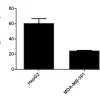- Empty cart.
- Continue Shopping

8-hydroxy 2 deoxyguanosine ELISA Kit
8-hydroxy 2 deoxyguanosine ELISA Kit
This product is currently out of stock and unavailable.
Key features and details
- Sensitivity: 0.59 ng/ml
- Range: 0.94 ng/ml – 60 ng/ml
- Sample type: Cell Lysate, Plasma, Saliva, Serum, Tissue Extracts, Urine
- Detection method: Colorimetric
- Assay type: Competitive
Overview
Product name
See all 8-hydroxy 2 deoxyguanosine kits
Detection method
Precision
| Sample | n | Mean | SD | CV% |
|---|---|---|---|---|
| Spiked | 90 | < 5% |
| Sample | n | Mean | SD | CV% |
|---|---|---|---|---|
| Spiked | 90 | < 5% |
Sample type
Assay type
Sensitivity
Range
Assay time
Assay duration
Product overview
8-hydroxy 2 deoxyguanosine ELISA Kit (8-OHdG) (ab201734) is a competitive assay that can be used for the quantification of 8-OHdG in urine, cell culture, plasma, and other sample matrices. The ELISA utilizes an 8-hydroxy-2-deoxyguanosine-coated plate and an HRP-conjugated antibody for detection which allows for an assay range of 0.94 – 60 ng/mL, with a sensitivity of 0.59 ng/mL. The other highlights of this kit are a quick incubation time of 60 minutes, stable reagents, and an easy to use protocol.
It is important to note that the 8-OHdG antibody used in this assay recognizes both free 8-OHdG and DNA-incorporated 8-OHdG. Since complex samples such as plasma, cell lysates, and tissues are comprised of mixtures of DNA fragments and free 8-OHdG, concentrations of 8-OHdG reported by ELISA methodology will not coincide with those reported by LC-MS where the single nucleoside is typically measured. This should be kept in mind when analyzing and interpreting experimental results.
Notes
8-hydroxy-2-deoxy Guanosine (8-OHdG) is produced by the oxidative damage of DNA by reactive oxygen and nitrogen species and serves as an established marker of oxidative stress. Hydroxylation of guanosine occurs in response to both normal metabolic processes and a variety of environmental factors (i.e., anything that increases reactive oxygen and nitrogen species). Increased levels of 8-OHdG are associated with the aging process as well as with a number of pathological conditions including cancer, diabetes, and hypertension.
In complex samples such as plasma, cell lysates, and tissues, 8-OHdG can exist as either the free nucleoside or incorporated in DNA. Once the blood enters the kidney, free 8-OHdG is readily filtered into the urine, while larger DNA fragments remain in the bloodstream. Because of the complexity of plasma samples, urine is a more suitable matrix for the measurement of free 8-OHdG than plasma. Urinary levels of 8-OHdG range between 2.7- 13 ng/mg creatine, while plasma levels of free 8-OHdG have been reported to be between 4-21 pg/mL as determined by LC-MS.
Platform
Properties
Storage instructions
| Components | 1 x 96 tests |
|---|---|
| 8-hydroxy-2-deoxy Guanosine Antibody Diluent (Blue) | 1 x 13ml |
| 8-Hydroxy-2-Deoxy Guanosine BSA Coated Plate | 1 unit |
| 8-hydroxy-2-deoxy Guanosine HRP Conjugated Monoclonal Antibody | 1 x 75µl |
| 8-hydroxy-2-deoxy Guanosine Sample and Standard Diluent (Red) | 1 x 50ml |
| 8-hydroxy-2-deoxy Guanosine Standard | 1 x 100µl |
| 8-hydroxy-2-deoxy Guanosine Stop Solution | 1 x 13ml |
| 8-hydroxy-2-deoxy Guanosine TMB Substrate | 1 x 13ml |
| 8-hydroxy-2-deoxy Guanosine Wash Buffer Concentrate (10X) | 1 x 50ml |
| Plate Cover | 2 units |
Research areas
Relevance
Alternative names
- 8 OH dG
























